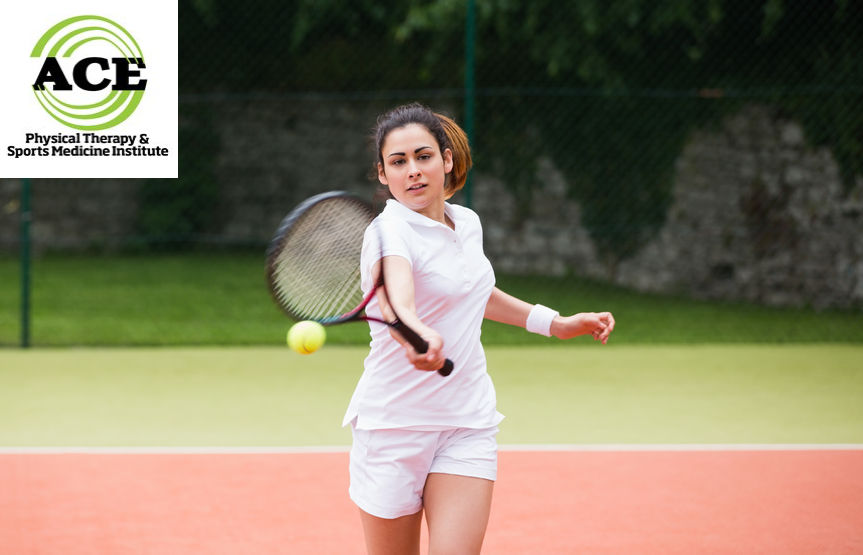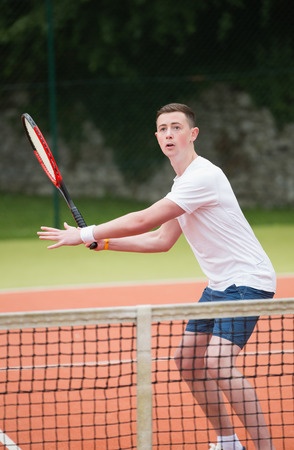TENNIS STRENGTH CONDITIONING

Tid Bits of Info
- Many people are treated for tennis elbow but never play tennis.
- “Get in shape to play the game, don’t play the game to get in shape!”
- Perform strengthening exercises 3x / week and attempt to do 30 repetitions of each exercise. (i.e. 3×10 or 2×1 5)
- Agilities should be performed several times per week and prior to playing as part of the “warm-up”.
- Ask a physical therapist for advice regarding a proper conditioning program if you plan to play tennis.
Tennis is a great game and can be played by almost anyone. With proper talent and conditioning, a player can reach levels of excellence. While Physical Therapists cannot give a tennis player talent, they can help players maximize performance and limit injuries through proper conditioning.
Top performance in tennis requires speed, strength, endurance and agility. An effective tennis strength conditioning routine focuses on the above aspects so that players can perform at the “top of their game.” This will include patient drills, activities, and exercises that can help players improve skills while also significantly reducing the likelihood of injury.
Core Conditioning
Core stabilization exercises are the first and possibly most important aspect of the strength-conditioning program. The core is the “foundation” of the body. A poorly conditioned core subjects the other parts of the body to forces and movements that could lead to injuries. Stability is key for properly performing joints. The proximal stability of the body begins at the core and helps to provide stable anchors for the distal body parts. For example, the power required to serve the tennis ball begins in the legs and is transferred through the core to the shoulder. A weak core is unable to transfer the power from the legs, so the shoulder joint is subjected to unnatural forces and could be injured.
Exercises:
Superman: Lie prone (on your stomach) with your arms outstretched overhead or assume the quadruped (kneeling with hands and knees on the ground). Slowly raise one arm and the opposite leg. Pause and then lower the arm and leg down.
Plank: Lie prone (on your stomach) and push yourself up off of the floor. Support your body weight on your forearms, elbows and toes. No other body part should touch the floor during the exercise. If it is too hard to support your body weight this way, you may allow your knees to touch the floor.
Side Plank: Lie on one side. Push your body weight up off of the floor and support it with our forearm and elbow on the side where you are lying. The side of your foot rests on the floor during the exercise routine. If this position is too difficult, keep the entire side of your leg below the knee on the floor during the exercise.
Shoulder Conditioning
Obviously, the shoulder joint is one of the most commonly injured body parts of a tennis player. The shoulder joint does not handle “over-head” motions very well. When over-head motion is combined with holding a racquet that extends the arm almost 2 feet, the torque and force that occur during the swing and serve can lead to injuries. If the shoulder is stable and strong, the chances of injuring it are reduced significantly. The shoulder blade (scapulae) must be stable and act as an “anchor” for the muscles of the shoulder. The four rotator cuff muscles can be injured during the tennis swing if the scapulae does not provide a stable origin when they contract to move the humerus (arm bone).
Exercises:
PULL APARTS: Stand and hold a piece of Theratubing (Rubber tubing can be purchased at most sporting goods stores or ask your Physical Therapist for a piece) of appropriate tensile strength in your hands. Your arms should be at or near shoulder level and your elbows should be fully extended (straight). Your palms should be facing each other so that your thumbs are pointed towards the ceiling. Slowly move your arms apart and stretch (“pull apart”) the Theraband The final phase of this exercise is to take your shoulder blades and squeeze them together.
”Y’s”: Lie with your arms in front of you, elbows straight. Your arms should be as close to your ears as possible, but it is fine if they are slightly separated away from the ears. Together, raise both your arms as high as possible. Most people can only raise them a few inches. The palms of the hands should remain facing the floor at all times. Pause and then lower them slowly to the starting position.
“T’s”: Lie in the same position as the previous exercise, but put your arms directly out to the side and keep them at shoulder level. Raise your arms together and attempt to squeeze your shoulder blades together at the same time. The palms of the hands should remain facing the floor at all times. Pause at the top and then return slowly to the starting position.
“I’s”: Lie in the same position and place your arms down at your sides. Your palms are facing the ceiling. Begin by retracting (squeezing) your shoulder blades together. When the shoulder blades are squeezed as firmly together as possible, raise the arms as high as possible. Pause and return slowly to the starting position.
Elbow Conditioning
Tennis elbow is tendinitis of the elbow. It is diagnosed when the outside of the elbow becomes very sore to the touch, and when that arm is attempting to forcefully grasp an object. The muscles and tendons of the elbow can be strengthened to prevent this injury.
Exercises:
RUBBERBAND FINGER EXTENSION: Place a rubberband (or several) on the ends of your fingers near the finger nails. Slowly spread your fingers apart and feel the resistance of the rubberband. Pause when your fingers are spread out fully and then slowly allow the fingers to return the beginning position.
WRIST EXTENSION: Standing or sitting, fully extend both arms. The palm of the hand to be stretched should be facing the ceiling. Put your fingers of the other hand on the fingers of the bottom hand and slowly push the bottom hand towards the floor. The wrist of the bottom hand will be pushed into an extended position and the stretch will be felt in the forearm.
Lower Extremities Conditioning
Lastly, the lower extremities must be in great shape to avoid an injury when someone plays tennis. The speed, agility and explosive power that is required to move into position to hit the ball puts a tremendous strain on the entire lower extremity. Practicing and performing specific strengthening exercises provides the training that the legs require to ward off an injury. Performing agility type exercises prepares the lower extremity joints for the movements that occur in a tennis match.
Exercises:
Squat: Stand in front of a chair as if you are going to sit down. Your feet should be shoulder width apart. Begin to “sit” down slowly and barely touch your buttocks to the chair seat. Return to an erect/standing position. As you lower yourself downward, your chest and head should be held upward and you should “stick out” your buttocks, don’t allow your kneecaps to move too far forward or beyond your toes. Don’t use your hands to assist the motion in either direction unless it is too difficult to perform.
Lunges: Stand with your feet shoulder width apart. Begin the exercise by striding forward with one leg. As the front leg makes contact with the ground begin to slowly lower yourself downward by bending your knees. The front knee should bend to approximately a 90 degree angle. You should stride out far enough that this knee bend can be accomplished without allowing the kneecap to “travel” way beyond the toes of that front foot. The body weight should be shifted to the front leg. The back leg knee flexion is minimal and helps to stabilize the body. Once you have reached the “bottom” of the descent towards the floor, pause and attempt to push yourself forcefully back to the beginning position utilizing the front leg as much as possible to generate the force. You can think that you have stepped on something sharp or hot and you have to get off of it.
Carioca run: Run sideways. Cross legs (legs in front, then legs in back). Hold arms straight out from shoulders for balance. Keep shoulders straight. Twist from hips as legs cross.
Defensive slides: Assume an athletic stance and move sideways. The lead foot is moved and the following foot is moved to meet the lead the foot. The following leg will “push” the lead foot and the near contact points should be the following forefoot and leading heal.
Tennis is a game that can be challenging, fun and competitive. It is also very physical and without proper conditioning, it can cause injuries to various parts of the body. A physical therapist can help players “get in shape” for tennis, and reduce the likelihood of injury.

























